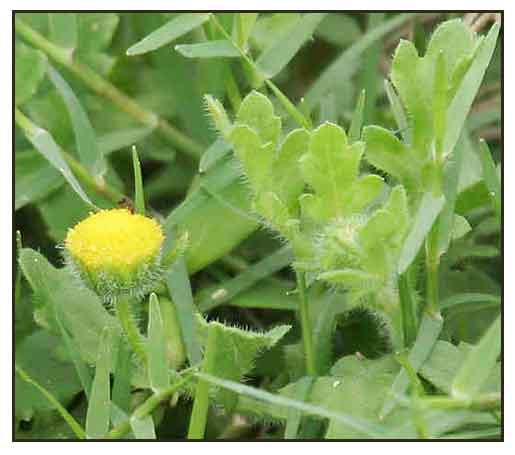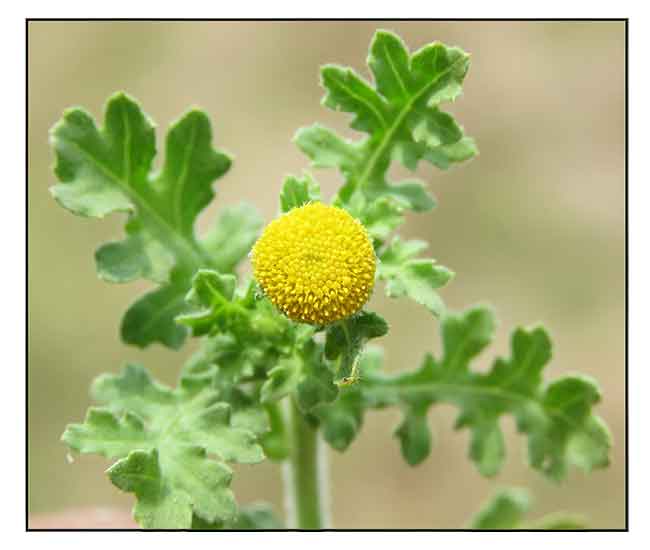 Gen info Gen info
- Grangea maderaspatana is a flowering plant in the family Asteraceae.
- Etymology: Genus name Grangea possibly honors Nicholas Tourtechot-Granger (c 1680-1734), a French physician and botanist gardener who had an interest in natural history. He was also honored with the genus Grangeria in the family Chrysobalanaceae. (23)
Botany
Pakopatoti-alog is a hairy, branched herb, spreading from the roots and growing up to 70 centimeters high. Buds are white and wooly. Leaves are 3 to 6 centimeters long, alternate, stalkless, sinuately pinnatifid, and divided into toothed lobes. Flowering heads are borne opposite the leaves, and are short-peduncled, rounded, and 8 to 10 millimeters in diameter. Flowers are small, very numerous, and yellow. Involucral bracts are ovate, thick, rigid, and hairy. Achenes are cylindric, glandular, and about 2 millimeters long. Pappus-hairs are connate, ending in a short, fimbriate tube.
Distribution
- Native to the Philippines.
-
An occasional weed in open, waste places in and about towns.
- In La Union, Pampanga, Bulacan and Rizal Provinces in Luzon.
- Also
occurs in tropical and subtropical Asia and Africa.
 Constituents Constituents
- Study isolated a diterpenoid from the acetone extract - 8-hydroxy-13E-labdane-15yl-acetate.
- Study of methanol extract yielded a total phenolic content of 121.45 ± 2.56 µg Gallic acid equivalent of phenol. (see study below) (2)
- Study of the whole plant isolated two new 5-deoxyflavones, 6-hydroxy-2′,4′,5′-trimethoxyflavone and 6-hydroxy-3′,4′,5′-trimethoxyflavone, together with a known flavone, 7,2′,4′-trimethoxyflavone.
- Study of whole plant isolated two new bioactive flavones: 5-deoxyflavones, 6-hydroxy-2′,4′,5′-trimethoxyflavone (1), 6-hydroxy-3′,4′,5′-trimethoxyflavone (2) and a known flavone, 7,2′,4′-trimethoxyflavone (3). (7)
- Major components of essential oil from fresh aerial parts were α-humulene (46.3%), β-caryophyllene (9.3%), α-copaene (8.2%), β-myrcene (4.3%), Z(E)-α-farnesene (3.7%), and calarene (3.5%).
The diverse volatile organic constituents showed significant acetylcholinesterase inhibitory activity with an IC50 value of 31.33 ± 1.03 µg/mL. (see study below) (11)
- Phytochemical screening of various extracts (PE/petroleum ether, C/chloroform, EA/ethyl acetate, M/methanol, W/water) yielded carbohydrates (M, W), phenolics and tannins (M, W),
saponins (M, W), steroids (PE, C, EA), flavonoids (M, W), terpenes (PE, C, EA, M, W). (see study below) (14)
- Study of extracts of aerial parts for essential oil yielded 21 compounds constituting 91.5% of the oil, which was characterized by the presence of sesquiterpenoids (sesquiterpenoid hydrocarbons 36.1% and oxygenated sesquiterpenoids 28.4%). Most abundant compounds were γ-gurjunene (26.5%), terpinyl acetate (20.8%), and hinesol (11.7%). (see study below) (17)
- GC-MS study for essential oil from aerial parts (0.06% v/w) yielded major components of α-humulene (46.3%), ß-caryophyllene (9.3%), α-copaene (8.2%), ß-myrcene (4.3%), Z(E)-α-farnesene (3.7%). and calarene (3.5%). (see study below) (24)
Properties
- Considered analgesic, stomachic, antiseptic, antispasmodic.
- Studies have suggested analgesic, anti-inflammatory, cytotoxic, hepatoprotective, diuretic antioxidant, estrogenic, anti-implantation, anticancer, acetylcholinesterase inhibitory properties.
Parts used
Leaves, roots.
Uses
Edibility
- Leaves are edible, raw or cooked. Reported to have narcotic effects. (9)
Folkloric
- In the Philippines, leaf infusion used as stomachic and antispasmodic.
- In India leaves are a valuable stomachic with deobstruent and antispasmodic properties. Also, prescribed as an infusion and electuary for obstructed menses and hysteria.
- Leaves sometimes used in antiseptic and anodyne preparations.
- In Odisha, India, roots of G. maderaspatana (agni-kumari) are chewed after meals for 15 days for dyspepsia. (12)
- Tamool doctors used the leaves for stomachic
, deobstruent, and antispasmodic properties. Infusion or electuary of leaves used for obstructed menses and hysteria. (13)
- In India, a popular medicinal plant used for knee joint rheumatism and muscle pains. (15)
- Leaf sap used externally for earaches. (16)
- In Odisha, India, natives chew roots after a meal to counter dyspepsia. (18)
- In China, tea from whole plant used for heat-clearing and detoxifying. (21)
- Leaf decoction used as post-partum tonic, to soothe coughing, and to treat irregular menses.
- In West Africa, used as stomachic.
- In Bangladesh, leaf juice taken internally as stomachic and applied externally for earache. (26)
Studies
• Analgesic: Study of methanol extract of the whole plant of Grangea maderaspatana showed a dose-dependent analgesic activity. At doses of 1 and 3 g/kg, there was significant (p<0.001) inhibition of acetic acid induced writhing in mice by 50% and 80%, respectively. (1)
• Antioxidant / Free Radical Scavenging: Study evaluated methanol extract for antioxidant activity. The ME exhibited significant (p<0.05) reducing power ability, DPPH radical scavenging activity, NO radical scavenging activity, H2O2 scavenging activity, and inhibition of ß-carotene bleaching. The antioxidant activity was concentration dependent, increasing with the amount of extract. Free radical scavenging and antioxidant activities may be attributed to the presence of phenolic and flavonoid compounds. (2)
• Estrogenic / Anti-implantation Efficacy: A mixture of flavonoids extracted from G. maderaspatana showed estrogenicity and anti-implantational activities in a mouse study. (4)
• Diterpenoid: Study of acetone extract yielded a new diterpenoids: 8-hydroxy- 13E-labdane-15yl-acetate.
• Toxicity Study: Using OECD guidelines, aqueous and alcoholic extracts of G. maderaspatana did not produced any mortality up to a dose of 2000 mg/kg p.o. (10) Extract containing 2000 mg/kg of different phytoconstituents administered by OECD guidelines per orem to six mice showed no behavioral effects or mortality. (14)
• Acetylcholinesterase Inhibitory Activity / Essential Oil: Study evaluated the volatile components of A. maderaspatana and its acetylcholinesteraze potential. Yield of essential oil from fresh aerial parts was 0.06% v/w. (see constituents above) (11)
• Anti-Anxiety: Study evaluated chloroform and methanol extracts of G. maderaspatana for anti-anxiety activity in mice using elevated plus maze testing. The chloroform extract showed significant anti-anxiety activity at 400 m/kg dose in mice. The activity was attributed to the presence of terpenoids, steroids, and saponins. (14)
• Antinociceptive / Anti-Rheumatic: Study evaluated the anti-nociceptive and antirheumatic and anti-inflammatory activity of G. maderaspatana in experimental models. Results showed antinociceptive activity using tail flick test, and anti-inflammatory and antirheumatic activities using carrageenan-induced rat paw edema and complete Freund's adjuvant (CFA)-induced arthritis models. (15)
• Antioxidant / Antimicrobial / Essential Oil /
Aerial Parts: Study of extracts of aerial parts for essential oil yielded 21 compounds constituting 91.5% of the oil. The oil showed antioxidant potential with significant reducing power (ASE/ml 2.01), chelating activity (IC50 1.80 ± 0.15), and DPPH radical scavenging activity (IC50 2.90 ± 0.96). Antimicrobial testing against one gram positive, four gram negative, and two fungi showed ZOI of the oil in range of 2.67 ± 0.58 to 11.00 mm and MIC range of 5 to 30 µg/mL. Activity was pronounced against C. albicans. (see constituents above) (17)
• Diterpenes / Gramaderins / Anti-Inflammatory: Study of ethanol extract isolated gramaderins A-D, along with 13 known compounds. The isolates were evaluated for anti-inflammatory activities. 5,7-dihydroxy-3,6,3',4',5'-pentamethoxyflavone and 5,3'-dihydroxy-3,6,7,4',5'-pentamethoxyflavone inhibited superoxide anion generation, while 8-Acetoxy-pentadeca-1,9Z,14-trien-4,6-diyne-3-ol demonstrated potent inhibition on elastase release. (19)
• Frullanolide / Anti-Breast Cancer by Apoptosis Induction: Study evaluated the anti-breast cancer potential of frullanolid, a compound isolated and purified from G. maderaspatana plant, against selected breast cancer cell lines. Frullanolide exhibited strong anti-breast cancer activity against MDA-MD-468 (IC50 8.04 ± 2.69 µg/ml) and weak cytotoxicity against MCF-7 and MDA-MB-231. The anticancer mechanism was elucidated via cellular apoptosis and present frullanolide as a possible novel approach to breast cancer therapy. (20)
• Acetylcholinesterase Inhibitory Activity / Potential for Alzheimer's / Essential Oil: Study evaluated the acetylcholinesterase inhibition potential of A. maderaspatana and the volatile components of aerial parts. GC-MS study for essential oil from aerial parts (0.06% v/w) yielded major components of α-humulene (46.3%), ß-caryophyllene (9.3%), α-copaene (8.2%), ß-myrcene (4.3%), Z(E)-α-farnesene (3.7%). and calarene (3.5%). Results showed the diverse volatile organic constituents have significant acetylcholinesterase inhibitory activity (IC50 of 31.33 ± 1.03 µg/mL). Results suggest potential novel AChE inhibitors in the VOCs of the plant. (24)
• Anticancer Effects / Triple Negative Breast Cancer Cells: Triple negative breast cancer (TNBC) is a breast cancer subtype characterized by absence of estrogen receptor, progesterone receptor, and human epidermal growth factor receptor 2 expression. TNBC cells respond poorly to targeted chemotherapies currently in use and mortality rate rate is high. Study evaluated the anticancer effects of 7-α-hydroxyfrullanolide (7HF), derived from G. maderaspatana, on MCF-7, MDA-MB-231 and MDA-MB-468 breast cancer cells using MTT assay. Results showed 7HF exhibits promising anti-TNBC activity and at low dose, it modulates signal transduction associated with G2/M-phase arrest and apoptosis. (25)
Availability
Wild-crafted.
|

![]()





